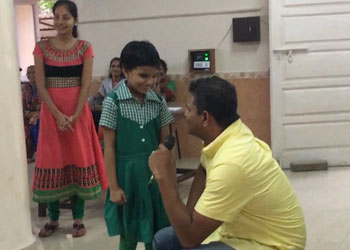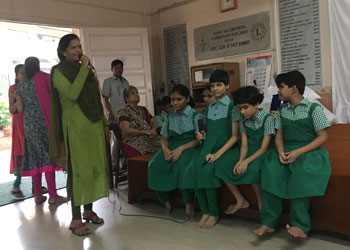Operation Drishti
I was introduced to the blind school in Mumbai by my daughter and my mom . During her annual visits to her grandmother in India my daughter frequented the Kamlaben Mehta Blind School. The school located in the heart of Mumbai city provides food, shelter and most importantly education to about 150 underprivileged blind girls and women between ages 3-50. About a third of these girls are pursuing higher education/ permanent jobs .Some of these girls orphans, abandoned by their families get a second chance on life and a place they can call home.
When we visited the school in Mumbai, we were awestruck by these talented girls, and their motivated teachers . Despite being differently abled and with limited resources (compared to the USA) their spirit and enthusiasm to overcome this major obstacle in life was astounding. We were given a tour of the school and the adjoining hostel by Mrs Jadhav , the principal of the blind school. It was quite heartening to learn that some of the teachers at the school ,themselves blind , were alumni of this school and now had dedicated their life to educating girls with their disability so their path had a few less obstacles. We were most impressed by the music teacher, Mrs Arya who herself blind and an alum of the school had trained some of the students so well that they had gone as far as competing in singing/ music competitions at a national level. One of her students had established a record by playing 105 different instruments within 45 minutes.



When we came back to the US , triggered by our daughters enthusiasm and her commitment, we as a family decided to do something to contribute towards blind education.We toured the blind school in Newark, New Jersey in order to get a sense of blind education in the USA and what we observed when we compared the system in 2 countries was that although the teachers and students in India were just as motivated, compared to blind schools in the US there was a stark contrast in resources. We noticed the ratio of brailers to kids was almost 1:1 in the US while in India this ratio was quite low with fewer brailers and more students. Also, the school in Newark had moved on from conventional brailers to digital brailers which were more interactive and facilitated easier understanding of the braille script thus enhancing faster learning.
My daughters observation about the ratio of brailers to students at the blind school motivated her to conduct a fundraiser in the USA and through the fundraiser she was able to buy two conventional brailers from the Perkins school for the blind, Massachusetts for her blind friends in India. Our eventual goal is to be able to generate enough funds to be able to provide digital brailers ( a conventional brailer cost is 700$ versus 5000$ for a digital brailer) for the girls in Mumbai to bring them upto speed with the rest of the developed world.
The goal of operation Drishti is not only to help with education but also to enhance the existing structure at the blind school. Although education is free , the kids themselves come from extremely humble backgrounds. Basic amenities like toiletries, clean clothes , feminine hygiene products are a luxury .
Our aim is to understand their needs and provide them with the tools to best assist their activities of daily living and harness their talent while also contributing to their education.Eventually the goal is to make sure that each one of these kids have the education and the vocational tools to sustain an independent life style and contribute to the society as responsible citizens.
At the time of writing this article, the alumni of this school have progressed on to become computer programmers, teachers, musicians, sculptors, call center operators just to name a few and most importantly many of them have gone on to become mothers and start a family of their own.



